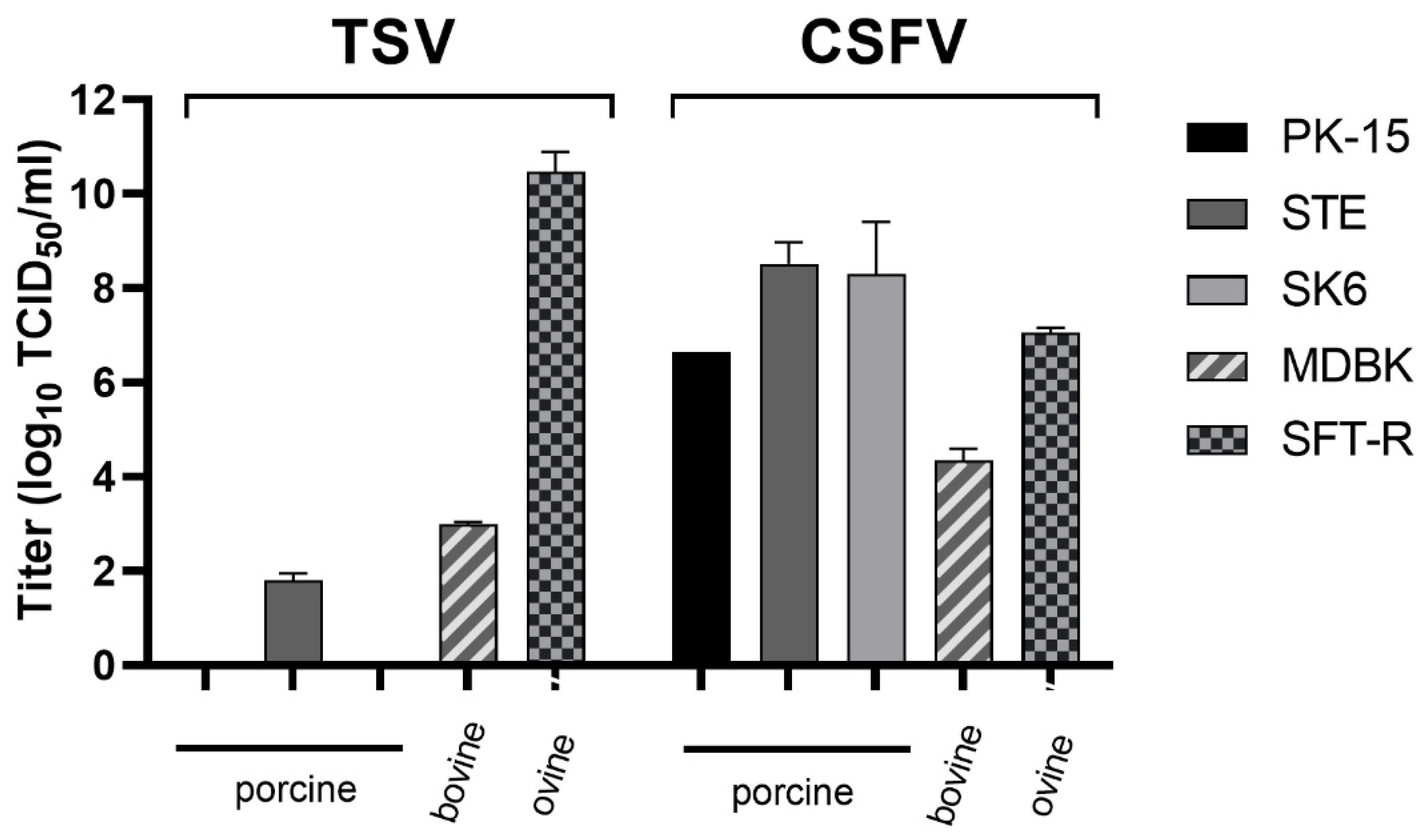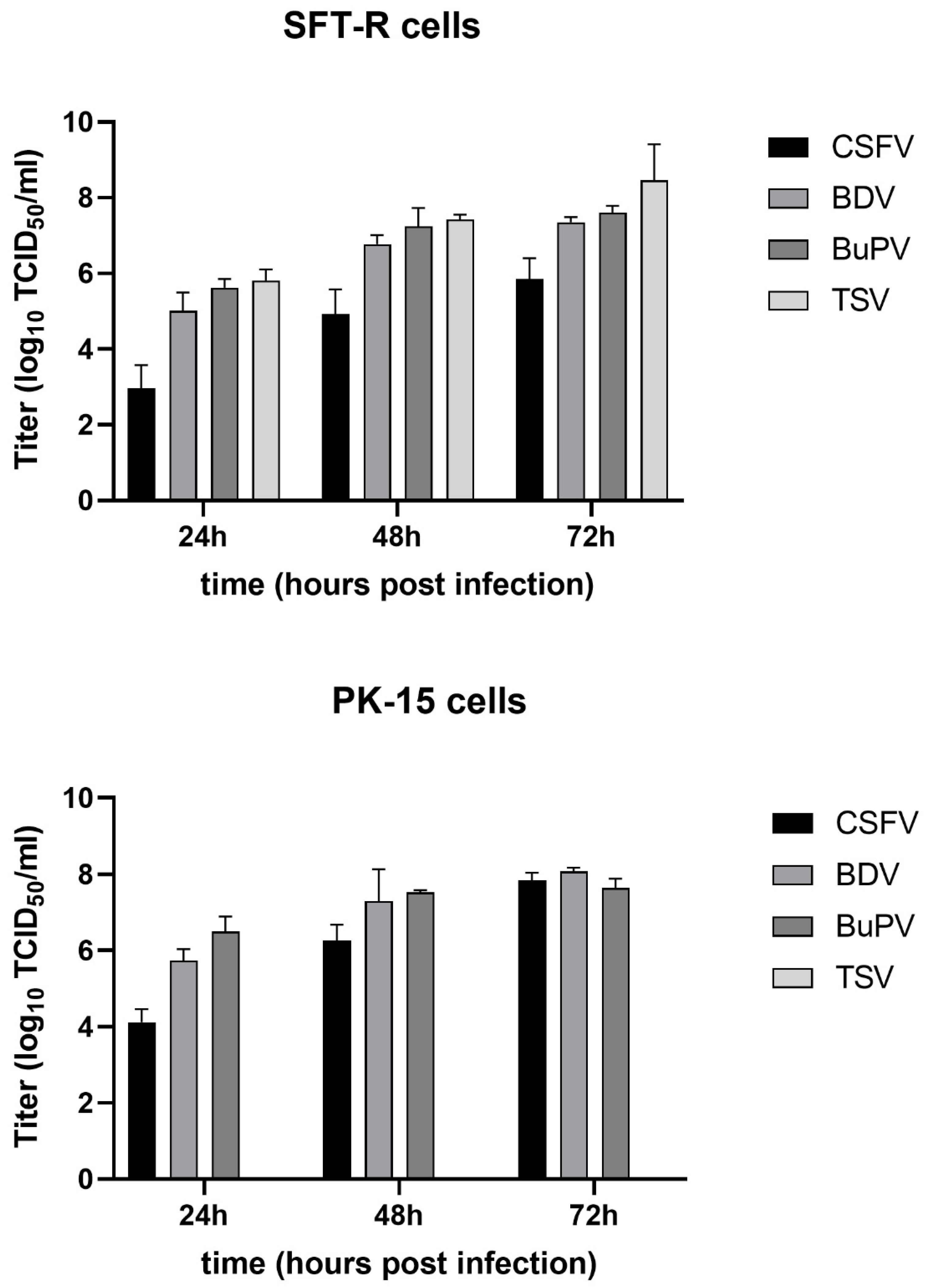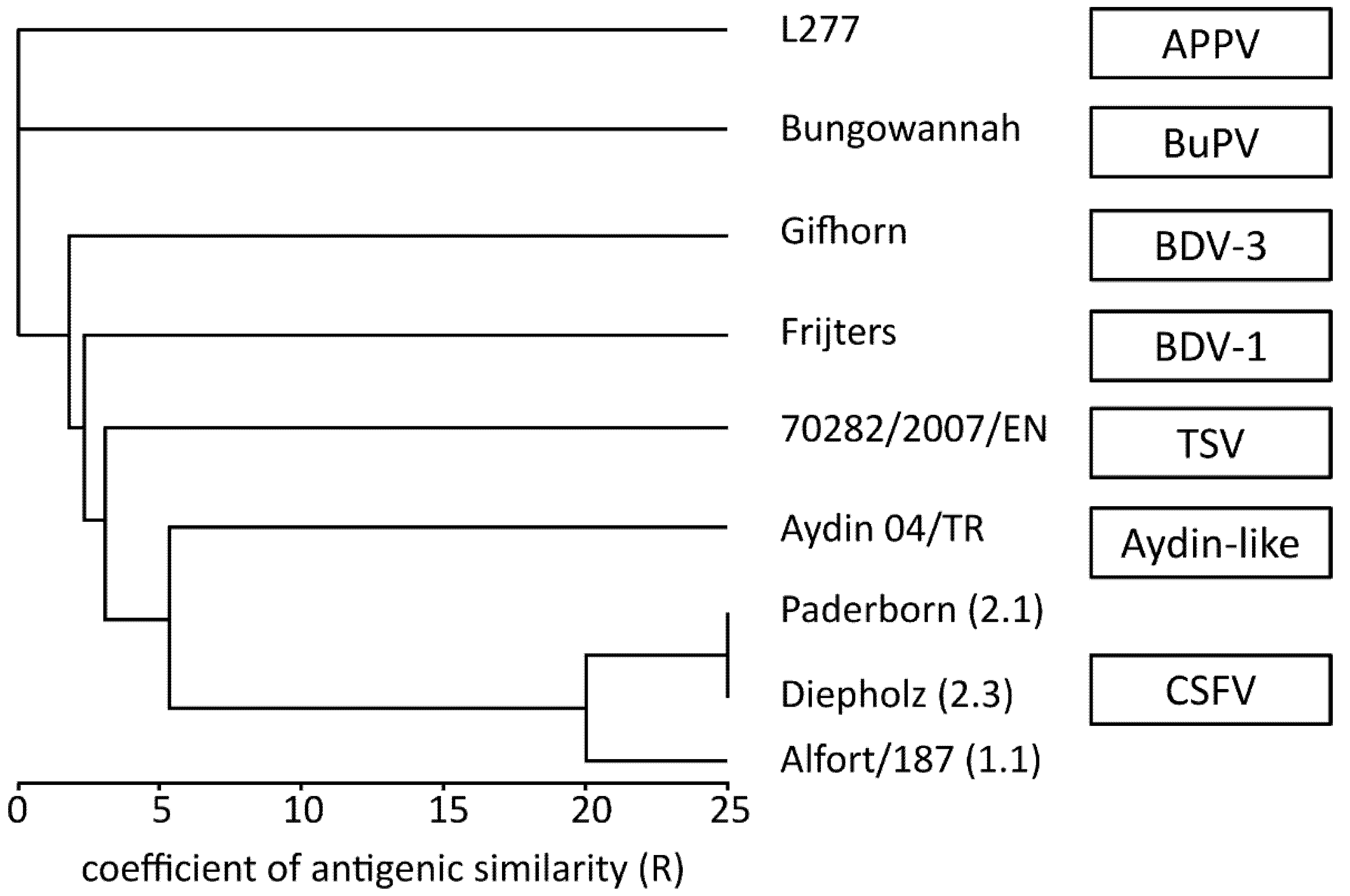Comparative Analysis of Tunisian Sheep-like Virus, Bungowannah Virus and Border Disease Virus Infection in the Porcine Host
Abstract
1. Introduction
2. Materials and Methods
2.1. Cells and Viruses
2.2. Antisera
2.3. Preparation of RNA and Real-Time (RT)-PCR
2.4. Complete Genome Sequencing and Phylogenetic Analysis
2.5. Determination of Virus Growth on Different Cell Lines
2.6. Animal Experiment
2.7. ELISA
2.8. Cross-Neutralization Test
3. Results
3.1. Genetic Characterization
3.2. Virus Growth on Different Cell Lines
3.3. Experimental Infection of Pigs
3.4. Antigenic Relatedness
3.5. Interference with Serological CSF Diagnosis
4. Discussion
5. Conclusions
Supplementary Materials
Author Contributions
Funding
Institutional Review Board Statement
Informed Consent Statement
Data Availability Statement
Acknowledgments
Conflicts of Interest
References
- Smith, D.B.; Meyers, G.; Bukh, J.; Gould, E.A.; Monath, T.; Scott Muerhoff, A.; Pletnev, A.; Rico-Hesse, R.; Stapleton, J.T.; Simmonds, P.; et al. Proposed revision to the taxonomy of the genus Pestivirus, family Flaviviridae. J. Gen. Virol. 2017, 98, 2106–2112. [Google Scholar] [CrossRef]
- Jo, W.K.; Van Elk, C.; Van De Bildt, M.; Van Run, P.; Petry, M.; Jesse, S.T.; Jung, K.; Ludlow, M.; Kuiken, T.; Osterhaus, A. An evolutionary divergent pestivirus lacking the Npro gene systemically infects a whale species. Emerg. Microbes Infect. 2019, 8, 1383–1392. [Google Scholar] [CrossRef] [PubMed]
- Wu, Z.; Liu, B.; Du, J.; Zhang, J.; Lu, L.; Zhu, G.; Han, Y.; Su, H.; Yang, L.; Zhang, S.; et al. Discovery of diverse rodent and bat pestiviruses with distinct genomic and phylogenetic characteristics in several Chinese provinces. Front. Microbiol. 2018, 9, 2562. [Google Scholar] [CrossRef] [PubMed]
- Sozzi, E.; Lavazza, A.; Gaffuri, A.; Bencetti, F.C.; Prosperi, A.; Lelli, D.; Chiapponi, C.; Moreno, A. Isolation and full-length sequence analysis of a pestivirus from aborted lamb fetuses in Italy. Viruses 2019, 11, 744. [Google Scholar] [CrossRef] [PubMed]
- Gao, W.-H.; Lin, X.-D.; Chen, Y.-M.; Xie, C.-G.; Tan, Z.-Z.; Zhou, J.-J.; Chen, S.; Holmes, E.C.; Zhang, Y.-Z. Newly identified viral genomes in pangolins with fatal disease. Virus Evol. 2020, 6, veaa020. [Google Scholar] [CrossRef] [PubMed]
- Lamp, B.; Schwarz, L.; Högler, S.; Riedel, C.; Sinn, L.; Rebel-Bauder, B.; Weissenböck, H.; Ladinig, A.; Rümenapf, T. Novel pestivirus species in pigs, Austria, 2015. Emerg. Infect. Dis. 2017, 23, 1176–1179. [Google Scholar] [CrossRef] [PubMed]
- Mosenav, A.C.S.; Weber, M.N.; Cibulski, S.P.; Silva, M.S.; Paim, W.P.; Silva, G.S.; Medeiros, A.A.; Viana, N.A.; Baumbach, L.F.; Puhl, D.E.; et al. Survey for pestiviruses in backyard pigs in southern Brazil. J. Vet. Diagn. Investig. 2020, 32, 136–141. [Google Scholar] [CrossRef]
- De Oliveira, L.G.; Mechler-Dreibi, M.L.; Almeida, H.M.S.; Gatto, I.R.H. Bovine viral diarrhea virus: Recent findings about its occurrence in pigs. Viruses 2020, 12, 600. [Google Scholar] [CrossRef]
- Nagai, M.; Aoki, H.; Sakoda, Y.; Kozasa, T.; Tominaga-Teshima, K.; Mine, J.; Abe, Y.; Tamura, T.; Kobayashi, T.; Nishine, K.; et al. Molecular, biological, and antigenic characterization of a border disease virus isolated from a pig during classical swine fever surveillance in Japan. J. Vet. Diagn. Investig. 2014, 26, 547–552. [Google Scholar] [CrossRef]
- Kawanishi, N.; Tsuduku, S.; Shimizu, H.; Ohtani, Y.; Kameyama, K.-I.; Yamakawa, M.; Tsutsui, T.; Matsuura, K.; Ohashi, S.; Isobe, T.; et al. First isolation of border disease virus in Japan is from a pig farm with no ruminants. Vet. Microbiol. 2014, 171, 210–214. [Google Scholar] [CrossRef]
- Kirkland, P.D.; Le Potier, M.-F.; Finlaison, D. Pestiviruses. In Diseases of Swine; Wiley: Hoboken, NJ, USA, 2019; pp. 622–640. [Google Scholar] [CrossRef]
- Loeffen, W.; Van Beuningen, A.; Quak, S.; Elbers, A. Seroprevalence and risk factors for the presence of ruminant pestiviruses in the Dutch swine population. Vet. Microbiol. 2009, 136, 240–245. [Google Scholar] [CrossRef] [PubMed][Green Version]
- Becher, P.; Orlich, M.; Shannon, A.D.; Horner, G.; Konig, M.; Thiel, H.J. Phylogenetic analysis of pestiviruses from domestic and wild ruminants. J. Gen. Virol. 1997, 78 Pt 6, 1357–1366. [Google Scholar] [CrossRef]
- Vilček, S.; Belák, S. Genetic identification of pestivirus strain Frijters as a border disease virus from pigs. J. Virol. Methods 1996, 60, 103–108. [Google Scholar] [CrossRef]
- Roehe, P.; Woodward, M.J.; Edwards, S. Characterisation of p20 gene sequences from a border disease-like pestivirus isolated from pigs. Vet. Microbiol. 1992, 33, 231–238. [Google Scholar] [CrossRef]
- Liess, B.; Moennig, V. Ruminant pestivirus infection in pigs. Rev. Sci. Tech. l’OIE 1990, 9, 151–161. [Google Scholar] [CrossRef]
- Ganges, L.; Crooke, H.R.; Bohórquez, J.A.; Postel, A.; Sakoda, Y.; Becher, P.; Ruggli, N. Classical swine fever virus: The past, present and future. Virus Res. 2020, 289, 198151. [Google Scholar] [CrossRef] [PubMed]
- Postel, A.; Meyer, D.; Cagatay, G.N.; Feliziani, F.; De Mia, G.M.; Fischer, N.; Grundhoff, A.; Milićević, V.; Deng, M.-C.; Chang, C.-Y.; et al. High abundance and genetic variability of atypical porcine pestivirus in pigs from Europe and Asia. Emerg. Infect. Dis. 2017, 23, 2104–2107. [Google Scholar] [CrossRef]
- Kirkland, P.; Frost, M.; King, K.; Finlaison, D.; Hornitzky, C.; Gu, X.; Richter, M.; Reimann, I.; Dauber, M.; Schirrmeier, H.; et al. Genetic and antigenic characterization of Bungowannah virus, a novel pestivirus. Vet. Microbiol. 2015, 178, 252–259. [Google Scholar] [CrossRef]
- Postel, A.; Schmeiser, S.; Oğuzoğlu, T.C.; Indenbirken, D.; Alawi, M.; Fischer, N.; Grundhoff, A.; Becher, P. Close relationship of ruminant pestiviruses and classical Swine Fever Virus. Emerg. Infect. Dis. 2015, 21, 668–672. [Google Scholar] [CrossRef]
- Casciari, C.; Sozzi, E.; Bazzucchi, M.; Martin, A.M.M.; Gaffuri, A.; Giammarioli, M.; Lavazza, A.; De Mia, G.M. Serological relationship between a novel ovine pestivirus and classical swine fever virus. Transbound. Emerg. Dis. 2020, 67, 1406–1410. [Google Scholar] [CrossRef] [PubMed]
- Wang, M.; Sozzi, E.; Bohórquez, J.A.; Alberch, M.; Pujols, J.; Cantero, G.; Gaffuri, A.; Lelli, D.; Rosell, R.; Bensaid, A.; et al. Decrypting the origin and pathogenesis in pregnant ewes of a new ovine pestivirus closely related to classical swine fever virus. Viruses 2020, 12, 775. [Google Scholar] [CrossRef]
- Bohórquez, J.A.; Sozzi, E.; Wang, M.; Alberch, M.; Abad, X.; Gaffuri, A.; Lelli, D.; Rosell, R.; Pérez, L.J.; Moreno, A.; et al. The new emerging ovine pestivirus can infect pigs and confers strong protection against classical swine fever virus. Transbound. Emerg. Dis. 2021. [Google Scholar] [CrossRef]
- Thabti, F.; Fronzaroli, L.; Dlissi, E.; Guibert, J.-M.; Hammami, S.; Pepin, M.; Russo, P. Experimental model of border disease virus infection in lambs: Comparative pathogenicity of pestiviruses isolated in France and Tunisia. Vet. Res. 2002, 33, 35–45. [Google Scholar] [CrossRef][Green Version]
- Thabti, F.; Letellier, C.; Hammami, S.; Pepin, M.; Ribiere, M.; Mesplede, A.; Kerkhofs, P.; Russo, P. Detection of a novel border disease virus subgroup in Tunisian sheep. Arch. Virol. 2004, 150, 215–229. [Google Scholar] [CrossRef] [PubMed]
- Ciulli, S.; Purpari, G.; Agnello, S.; Di Marco, P.; Di Bella, S.; Volpe, E.; Mira, F.; de Aguiar Saldanha Pinheiro, A.C.; Vullo, S.; Guercio, A. Evidence for Tunisian-like pestiviruses presence in small ruminants in Italy since 2007. Transbound. Emerg. Dis. 2016, 64, 1243–1253. [Google Scholar] [CrossRef]
- Dubois, E.; Russo, P.; Prigent, M.; Thiéry, R. Genetic characterization of ovine pestiviruses isolated in France, between 1985 and 2006. Vet. Microbiol. 2008, 130, 69–79. [Google Scholar] [CrossRef] [PubMed]
- Rios, L.; Coronado, L.; Naranjo-Feliciano, D.; Martínez-Pérez, O.; Perera, C.L.; Hernandez-Alvarez, L.; De Arce, H.D.; Núñez, J.I.; Ganges, L.; Pérez, L.J. Deciphering the emergence, genetic diversity and evolution of classical swine fever virus. Sci. Rep. 2017, 7, 17887. [Google Scholar] [CrossRef]
- Becher, P.; Ramirez, R.A.; Orlich, M.; Rosales, S.C.; König, M.; Schweizer, M.; Stalder, H.; Schirrmeier, H.; Thiel, H.-J. Genetic and antigenic characterization of novel pestivirus genotypes: Implications for classification. Virology 2003, 311, 96–104. [Google Scholar] [CrossRef]
- Fahnøe, U.; Höper, D.; Schirrmeier, H.; Beer, M.; Rasmussen, T.B. Complete genome sequence of border disease virus genotype 3 strain Gifhorn. Genome Announc. 2014, 2, e01142-13. [Google Scholar] [CrossRef]
- Postel, A.; Meyer, D.; Petrov, A.; Becher, P. Recent emergence of a novel porcine pestivirus: Interference with classical swine fever diagnosis? Emerg. Microbes. Infect. 2017, 6, e19. [Google Scholar] [CrossRef] [PubMed]
- Becher, P.; Orlich, M.; Thiel, H.-J. Complete genomic sequence of Border disease virus, a pestivirus from sheep. J. Virol. 1998, 72, 5165–5173. [Google Scholar] [CrossRef] [PubMed]
- Cagatay, G.N.; Antos, A.; Meyer, D.; Maistrelli, C.; Keuling, O.; Becher, P.; Postel, A. Frequent infection of wild boar with atypical porcine pestivirus (APPV). Transbound. Emerg. Dis. 2018, 65, 1087–1093. [Google Scholar] [CrossRef] [PubMed]
- Fischer, N.; Indenbirken, D.; Meyer, T.; Lutgehetmann, M.; Lellek, H.; Spohn, M.; Aepfelbacher, M.; Alawi, M.; Grundhoff, A. Evaluation of unbiased next-generation sequencing of RNA (RNA-seq) as a diagnostic method in influenza virus-positive respiratory samples. J. Clin. Microbiol. 2015, 53, 2238–2250. [Google Scholar] [CrossRef] [PubMed]
- Fischer, N.; Rohde, H.; Indenbirken, D.; Günther, T.; Reumann, K.; Lutgehetmann, M.; Meyer, T.; Kluge, S.; Aepfelbacher, M.; Alawi, M.; et al. Rapid metagenomic diagnostics for suspected outbreak of severe pneumonia. Emerg. Infect. Dis. 2014, 20, 1072–1075. [Google Scholar] [CrossRef]
- Jones, D.T.; Taylor, W.R.; Thornton, J.M. The rapid generation of mutation data matrices from protein sequences. Bioinformatics 1992, 8, 275–282. [Google Scholar] [CrossRef]
- Kumar, S.; Stecher, G.; Li, M.; Knyaz, C.; Tamura, K. MEGA X: Molecular evolutionary genetics analysis across computing platforms. Mol. Biol. Evol. 2018, 35, 1547–1549. [Google Scholar] [CrossRef] [PubMed]
- Anonymous. Manual of Diagnostic Tests for Detection of CSF. Available online: https://www.tiho-hannover.de/kliniken-institute/institute/institut-fuer-virologie/eu-and-oie-reference-laboratory/diagnostic-methods (accessed on 16 June 2021).
- Archetti, I.; Horsfall, F.L., Jr. Persistent antigenic variation of influenza a viruses after incomplete neutralization in ovo with heterologous immune serum. J. Exp. Med. 1950, 92, 441–462. [Google Scholar] [CrossRef] [PubMed]
- Anonymous. Manual of Diagnostic Tests and Vaccines for Terrestrial Animals 2021; Chapter 3.9.3: Classical Swine Fever (Infection with Classical Swine Fever Virus). Available online: https://www.oie.int/en/what-we-do/standards/codes-and-manuals/terrestrial-manual-online-access/ (accessed on 1 July 2021).
- Meyer, D.; Petrov, A.; Becher, P. Inactivation of classical swine fever virus in porcine serum samples intended for antibody detection. Pathogens 2019, 8, 286. [Google Scholar] [CrossRef]
- Becher, P.; Shannon, A.D.; Tautz, N.; Thiel, H.-J. Molecular Characterization of border disease virus, a pestivirus from sheep. Virology 1994, 198, 542–551. [Google Scholar] [CrossRef]
- Finlaison, D.S.; King, K.R.; Gabor, M.; Kirkland, P.D. An experimental study of Bungowannah virus infection in weaner aged pigs. Vet. Microbiol. 2012, 160, 245–250. [Google Scholar] [CrossRef] [PubMed]
- Postel, A.; Schmeiser, S.; Zimmermann, B.; Becher, P. The European classical swine fever virus database: Blueprint for a pathogen-specific sequence database with integrated sequence analysis tools. Viruses 2016, 8, 302. [Google Scholar] [CrossRef] [PubMed]
- Liao, X.; Wang, Z.; Cao, T.; Tong, C.; Geng, S.; Gu, Y.; Zhou, Y.; Li, X.; Fang, W. Hypervariable antigenic region 1 of classical swine fever virus E2 protein impacts antibody neutralization. Vaccine 2016, 34, 3723–3730. [Google Scholar] [CrossRef] [PubMed]
- Moening, V. Pestiviruses: A review. Vet. Microbiol. 1990, 23, 35–54. [Google Scholar] [CrossRef]
- Postel, A.; Hansmann, F.; Baechlein, C.; Fischer, N.; Alawi, M.; Grundhoff, A.; Derking, S.; Tenhündfeld, J.; Pfankuche, V.M.; Herder, V.; et al. Presence of atypical porcine pestivirus (APPV) genomes in newborn piglets correlates with congenital tremor. Sci. Rep. 2016, 6, 27735. [Google Scholar] [CrossRef] [PubMed]





| Virus | Animal Number | Cq Values | ||||
|---|---|---|---|---|---|---|
| 0 dpi 1 | 3 dpi | 5 dpi | 7 dpi | 14 dpi | ||
| TSV | 3085 | - | - | 38.9 | 35.9 | 39.0 |
| TSV | 3090 | - | - | - | 38.6 | n.t. 2 |
| TSV | 3092 | - | - | n.t. | 36.1 | - |
| TSV | 3096 | - | - | - | - | n.t. |
| BuPV | 3080 | - | n.t. | n.t. | 35.6 | - |
| BuPV | 3086 | - | 35.6 | 33.8 | 36.3 | - |
| BuPV | 3093 | - | 38.3 | 34.6 | 36.0 | 39.0 |
| BDV | 3087 | - | - | 36.1 | - | - |
| BDV | 3088 | - | - | - | - | - |
| BDV | 3094 | - | - | - | n.t. | - |
| Virus | Animal Number | CSFV ELISA | NT 4 | ||||
|---|---|---|---|---|---|---|---|
| BVDV NADL | BDV Moredun | CSFV Alfort/187 | CSFV Diepholz | Homologous Virus | |||
| TSV | 3085 | pos. 1 | 20 | 20 | - | 160 | 640 |
| TSV | 3090 | neg. 2 | - | - | - | 40 | 240 |
| TSV | 3092 | dbtf. 3 | 15 | 10 | - | 160 | 480 |
| TSV | 3096 | neg. | - | - | - | 30 | 640 |
| BDV | 3087 | neg. | 10 | 30 | - | 240 | 1280 |
| BDV | 3088 | neg. | - | 20 | 10 | 320 | 1280 |
| BDV | 3094 | neg. | 40 | 30 | 20 | 480 | 1920 |
| BuPV | 3080 | neg. | - | - | - | - | 2560 |
| BuPV | 3086 | neg. | - | - | - | - | 6400 |
| BuPV | 3093 | neg. | - | - | - | - | 3200 |
Publisher’s Note: MDPI stays neutral with regard to jurisdictional claims in published maps and institutional affiliations. |
© 2021 by the authors. Licensee MDPI, Basel, Switzerland. This article is an open access article distributed under the terms and conditions of the Creative Commons Attribution (CC BY) license (https://creativecommons.org/licenses/by/4.0/).
Share and Cite
Meyer, D.; Postel, A.; Wiedemann, A.; Cagatay, G.N.; Ciulli, S.; Guercio, A.; Becher, P. Comparative Analysis of Tunisian Sheep-like Virus, Bungowannah Virus and Border Disease Virus Infection in the Porcine Host. Viruses 2021, 13, 1539. https://doi.org/10.3390/v13081539
Meyer D, Postel A, Wiedemann A, Cagatay GN, Ciulli S, Guercio A, Becher P. Comparative Analysis of Tunisian Sheep-like Virus, Bungowannah Virus and Border Disease Virus Infection in the Porcine Host. Viruses. 2021; 13(8):1539. https://doi.org/10.3390/v13081539
Chicago/Turabian StyleMeyer, Denise, Alexander Postel, Anastasia Wiedemann, Gökce Nur Cagatay, Sara Ciulli, Annalisa Guercio, and Paul Becher. 2021. "Comparative Analysis of Tunisian Sheep-like Virus, Bungowannah Virus and Border Disease Virus Infection in the Porcine Host" Viruses 13, no. 8: 1539. https://doi.org/10.3390/v13081539
APA StyleMeyer, D., Postel, A., Wiedemann, A., Cagatay, G. N., Ciulli, S., Guercio, A., & Becher, P. (2021). Comparative Analysis of Tunisian Sheep-like Virus, Bungowannah Virus and Border Disease Virus Infection in the Porcine Host. Viruses, 13(8), 1539. https://doi.org/10.3390/v13081539






